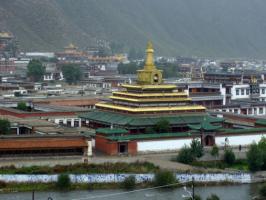Tourist Attractions along Qiqihar-Urumqi Railway Line
The first Qiqihar-Urumqi railway, K1084, started running on May 15, 2016. Stretching for over 4,000 kilometres, it's the longest railway line in China.
As the first direct line between the most northeastern province and the most northwestern region of the country, it passes across 8 provinces and the city of Tianjin.
For the cost of 1,244 yuan, or 190 US dollars, travelers can cover almost all of Northern China.
Among the 40 stations the train stops at, many are well-known places of interest. It's not practical to visit them all, but the following four pairs of cities are worth travelers' time.
Qiqihar & Harbin
Qiqihar is the second largest city in Northeast China's Heilongjiang province. It has the Zhalong Nature Preserve, a first-class wetland known as a stopover and nesting area for cranes.
The marshland is a major migratory route for birds from the Arctic migrating to Southeast Asia. Its ponds and reeds make it an ideal home for over 300 different species including storks, swans, herons and grebes.
310 km away from the city lays Harbin, capital of the province, which is notable for its ice sculpture festival in winter and national music festival in summer.
If travelers happen to miss both, there is the third choice -- European-style architecture and food. The must-go first stop has to be Saint Sophia Cathedral, a former Russian Orthodox church built in 1907.
As a perfect example of Neo-Byzantine architecture, its main structure is laid out like a cross with the main hall topped with a huge green-tipped dome. Under the bright sun, the church and the square resemble Moscow's Red Square.
Harbin has a 100,000-square-km "Russian village" for nostalgic tourists who have a crush on the exotic land, where they can appreciate 27 villas and residential buildings of Russian manners popular during the last century.
Zhangye & Jiayuguan
The two cities are located in Hexi Corridor in northwest China's Gansu Province, which was the frontier for much of China's history as it formed a natural passage to the Central Asian and the Middle East. Zhangye literally means "extend the arm", suggesting Ancient China's intentions to communicate with foreign countries.
The city is now known for the Zhangye Danxia National Geological Park. Danxia is a landform with unusual colours of rocks, which are smooth, sharp and several hundred meters tall. They are the result of deposits of sandstone and minerals over 24 million years, with shapes sculpted by wind, rain, and time.
Next station towards west along the railway is Jiayuguan, a city famous for Jiayu Pass, the largest and most intact pass of the Great Wall of China. It also marks the end of the Wall.
Besides sightseeing, one cannot miss the noodles and drinks in Jianyuguan, which represents the flavour of northwest China yet is less expensive than those in neighbouring cities.
Different kinds of northwest noodles can all be found here. For example, there are Lanzhou beef noodles, soft, elastic, with cubes of beef and egg scattering. Decorated by green coriander and red pepper oil, the noodles seldom fail the diners' appetite.
Hami & Turpan
The two cities are in Xinjiang Uygur Autonomous Region, the railway's terminal.
Exiting Gansu Province, the first city travellers reach is Hami, the hometown of sweet Hami melons, the only thing many outsiders able to able to think of when mentioning the city.
Barkol Grassland is 1,650 meters above sea level. Jokuls are glittering and translucent, with verdant pine forests and wreathing clouds making the scenery changeable.
If Hami is sweet melons' city, Turpan is for grapes. It has an eight-metre valley named Bulayiq with grapes growing in abundance.
The major species is 13 categories of seedless grapes, of which the sugar content is 20 percent to 24 percent, higher than those in the rest of the world. That's the result of plenty of sunlight and the meltwater form the nearby snow mountain.














